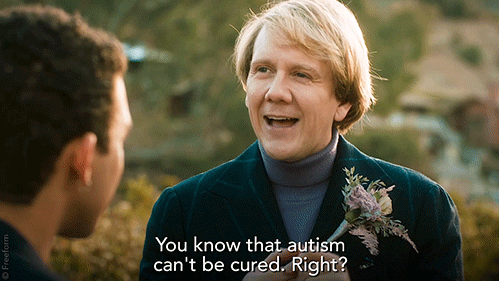The GAPS Diet and Rethinking Autism
A natural treatment approach to mood and behavioural disorders

Meet Dr Natasha Campbell-McBride, a medical doctor with two postgraduate degrees, Master of Medical Sciences in Neurology and Master of Medical Sciences in Human Nutrition.
Dr Campbell-McBride is known for developing the concept of GAPS (Gut and Psychology Syndrome), a natural treatment approach to mood and behavioural disorders such as autism, ADHD/ADD, dyslexia, dyspraxia, depression and schizophrenia.
Her journey started after she discovered her 3-year-old child was diagnosed with autism. This discovery led her to go back to university, learn human nutrition and as the result of her research and intervention via her GAPS Nutritional Protocol, her child recovered fully.

Dr Campbell-McBride's insights into patterns she was seeing between neurological and digestive disorders led to her writing her book "Gut and Psychology Syndrome" and she now spends her time educating other practitioners on the GAPS Nutritional Protocol allowing her to magnify its reach outside of her own clinical practice.
When discovered that autism is a curable disorder she started working with many other children with autism and A.D.H.D. and other learning disabilities and found that what she has done with her own child works on those children as well, helps them to recover as well.
Back in 1984, when she graduated from medical school, autism was an exceptionally rare disorder, with a prevalence of about 1 in 10,000.
By the time I graduated from medical school I had never seen an autistic individual… To be honest, the first autistic child that I encountered was my own… Five years ago we were diagnosing one child in 150, which is almost a 40-fold increase in incidence. Now in Britain and some countries, we are diagnosing one child in 66.
The rates are similar in the United States, Australia, and New Zealand as well. Australia’s prevalence is 88.20 per 10,000 Children (the 24th highest in the world) compared to United Kingdom 78.10 per 10,000 Children or Spain 73 per 10,000 Children
Autism Spectrum Australia has revised its autism prevalence rates from 1 in 100 to an estimated 1 in 70 people in Australia on the autism spectrum. That is an estimated 40% increase or around 353,880 people.
In 2020, the CDC reported that approximately 1 in 54 children in the U.S. with 31% of children with ASD have an intellectual disability.
- 1 in 34 boys identified with autism
- 1 in 144 girls identified with autism
Early treatment is key
Dr Campbell explains, the younger the child is when you start the treatment, the better the results.
When we start the GAPS treatment at the age of 2, 3, 4, up to 5, you give your child a real chance to completely recover from autism, from ADHD, ADD, dyslexia and dyspraxia—and that larger group of children who do not fit into any diagnostic box… These are the children with whom doctors usually procrastinate.
Dr. Campbell is convinced that autistic children are in fact born with perfectly normal brains and perfectly normal sensory organs.
What happens in these children [is that] they do not develop normal gut flora from birth… Gut flora is a hugely important part of our human physiology. Recently research in Scandinavia has demonstrated that 90 percent of all cells and all genetic material in a human body is our own gut flora. We are just a shell… a habitat for this mass of microbes inside us.
As a result, their digestive system—instead of being a source of nourishment for these children—becomes a major source of toxicity. These pathogenic microbes inside their digestive tract damage the integrity of the gut wall. So all sort of toxins and microbes flood into the bloodstream of the child, and get into the brain of the child.
That usually happens in the second year of life in children who were breast fed because breastfeeding provides a protection against this abnormal gut flora. In children who were not breastfed, I see the symptoms of autism developing in the first year of life. So breastfeeding is crucial to protect these children.”
Brain Toxicity Leads to Symptoms of Autism
Children use all of their sensory organs to collect information from their environment, which is then passed to the brain for processing. This is a fundamental part of learning.
However, in children with Gut and Psychology Syndrome (GAPS), the toxicity flowing from their gut throughout their bodies and into their brains, clogs the brain with toxicity, preventing it from performing its normal function and process sensory information…
Sensory information turns into this mush; into a noise in the child’s brain, and from this noise the child cannot learn. They cannot decipher anything useful
If the child’s brain is clogged with toxicity, the child misses that window of opportunity of learning and starts developing autism depending on the mixture of toxins, depending on how severe the whole condition is, and how severely abnormal the gut flora is in the child.
GAPS may manifest as a conglomerate of symptoms that can fit the diagnosis of either autism, or attention deficit hyperactivity disorder (ADHD), attention deficit disorder (ADD) without hyperactivity, dyslexia, dyspraxia, or obsessive-compulsive disorder, just to name a few possibilities
As far as science knows, the baby inside the mother’s womb during nine months of gestation is sterile. The baby’s gut is sterile. The baby acquires its gut flora at the time of birth, when the baby goes through the birth canal of the mother. So whatever lives in mom’s birth canal, in mom’s vagina, becomes the baby’s gut flora.
The vaginal flora comes from the bowel. So if the mother has abnormal gut flora, she will have abnormal flora in her birth canal. Fathers are not exempt because fathers also have gut flora, and that gut flora populates their groin and they share their groin flora with the mother on a regular basis.
Every course of broad spectrum antibiotics wipes out the beneficial species of microbes in the gut, which leaves the pathogens in there uncontrolled.
The Importance of Fermented Foods and Probiotics
This is why it’s so important to ‘reseed’ your gut with fermented foods and probiotics when you’re taking an antibiotic. If you aren’t eating fermented foods, you most likely need to supplement with a probiotic on a regular basis, especially if you’re eating a lot of processed foods.
Every course of antibiotics tends to wipe out the beneficial bacteria and that gives a window of opportunity for the pathogens to proliferate, to grow uncontrolled, and to occupy new niches in your gut. The beneficial flora recovers, but different species of it take between two weeks to two months to recover in the gut and that’s a window of opportunity for various pathogens to overgrow.
What I see in the families of autistic children is that 100 percent of mom’s of autistic children have abnormal gut flora and health problems related to that.
In essence, what we have is a generational build-up of abnormal gut flora, with each generation becoming ever more prone to being further harmed from the use of antibiotics—and vaccines as well, which I’ll discuss in a moment.
Bottle-Feeding, Antibiotics, Contraceptives and Diet
We now know that breastfed babies develop entirely different gut flora compared to bottle-fed babies. Infant formula never was, and never will be a healthy replacement to breast milk, for a number of reasons; altered gut flora being one of them, a large percentage of the mothers of autistic children were bottle-fed. Then, as they received many courses of antibiotics throughout their childhood, the abnormalities in their gut flora further deepened.
Ever since antibiotics were prescribed, particularly from the 50s and 60s, they were prescribed for every cough and sneeze. They really over-prescribed antibiotics. And with every course of antibiotics, the abnormalities in the gut flora would get deeper and deeper in these girls. And then, at the age of 15, 16, these ladies were put on a contraceptive pill… [which] have a devastating effect on the gut flora.
Bottle-feeding along with over-use of antibiotics and use of the contraceptive pill set the stage for increasingly abnormal gut flora with each passing generation. Then, add to that a diet of processed junk food and excessive consumption of high fructose corn syrup and you have a prescription for disaster in terms of intestinal health.
It’s important to realize that processed foods and sugar almost exclusively feed pathogens in your digestive system, allowing them to proliferate.
While the baby is breastfed, despite the fact that the baby has acquired abnormal gut flora from the mom, there will be some protection. But as soon as the breastfeeding stops that protection stops as well. That is the time when the abnormalities in the gut flora really flourish and the child starts sliding down into autism or ADHD or ADD or any other learning disability or physical problems such as diabetes type 1, for example, and celiac disease or other autoimmune conditions, or… asthma, eczema and other physical problems.
The GAPS diet
The GAPS diet is a strict elimination diet that requires its followers to cut out:
- grains
- pasteurized dairy
- starchy vegetables
- refined carbs

Her theory is that a leaky gut causes many conditions that affect your brain. The leaky gut syndrome is the term used to describe an increase in the permeability of the gut wall
The GAPS theory is that a leaky gut allows chemicals and bacteria from your food and environment to enter your blood when they wouldn’t normally do so.
It claims that once these foreign substances enter your blood, they can affect your brain’s function and development, causing “brain fog” and conditions like autism.
The GAPS protocol is designed to heal the gut, preventing toxins from entering the bloodstream and lowering “toxicity” in the body.
Dr. Campbell-McBride She now widely promotes the diet as a natural cure for many psychiatric and neurological conditions, including:
- autism
- ADD and ADHD
- dyspraxia
- dyslexia
- depression
- schizophrenia
- Tourette’s syndrome
- bipolar disorder
- obsessive-compulsive disorder (OCD)
- eating disorders
- gout
- childhood bed-wetting
The diet also claims to help children who have a food intolerance or allergy.
Following the GAPS diet can be a years-long process. It requires you to cut out all foods Dr Campbell-McBride thinks contribute to a leaky gut. This includes all grains, pasteurized dairy, starchy vegetables and refined carbs.
The GAPS protocol is made up of three main stages:
- the GAPS introduction diet
- the full GAPS
- a reintroduction phase for coming off of the diet
Introduction phase: Elimination
The introduction phase is the most intense part of the diet because it eliminates most foods. It’s called the “gut healing phase” and can last from three weeks to one year, depending on your symptoms.
This phase is broken down into six stages:
- Stage 1: Consume homemade bone broth, juices from probiotic foods and ginger, and drink mint or chamomile tea with honey between meals. People who are not dairy intolerant may eat unpasteurized, homemade yogurt or kefir.
- Stage 2: Add in raw organic egg yolks, ghee and stews made with vegetables and meat or fish.
- Stage 3: All previous foods plus avocado, fermented vegetables, GAPS-recipe pancakes and scrambled eggs made with ghee, duck fat, or goose fat.
- Stage 4: Add in grilled and roasted meats, cold-pressed olive oil, vegetable juice, and GAPS-recipe bread.
- Stage 5: Introduce cooked apple purée, raw vegetables starting with lettuce and peeled cucumber, fruit juice, and small amounts of raw fruit, but no citrus.
- Stage 6: Finally, introduce more raw fruit, including citrus.
During the introduction phase, the diet requires you to introduce foods slowly, starting with small amounts and building up gradually.
The diet recommends that you move from one stage to the next once you are tolerating the foods you have introduced. You are considered to be tolerating food when you have a normal bowel movement.
Once the introduction diet is complete, you can move to the full GAPS diet.
Maintenance phase: The full GAPS diet
The full GAPS diet can last 1.5–2 years. During this part of the diet, people are advised to base the majority of their diet on the following foods:
- fresh meat, preferably hormone-free and grass-fed
- animal fats, such as lard, tallow, lamb fat, duck fat, raw butter, and ghee
- fish
- shellfish
- organic eggs
- fermented foods, such as kefir, homemade yogurt and sauerkraut
- vegetables
Followers of the diet can also eat moderate amounts of nuts and GAPS-recipe baked goods made with nut flours.
There are also a number of additional recommendations that go along with the full GAPS diet. These include:
- Do not eat meat and fruit together.
- Use organic foods whenever possible.
- Eat animal fats, coconut oil, or cold-pressed olive oil at every meal.
- Consume bone broth with every meal.
- Consume large amounts of fermented foods, if you can tolerate them.
- Avoid packaged and canned foods.
While on this phase of the diet, you should avoid all other foods, particularly refined carbs, preservatives, and artificial colourings.
Reintroduction phase: Coming off GAPS
If you’re following the GAPS diet to the letter, you’ll be on the full diet for at least 1.5–2 years before you start reintroducing other foods.
The diet suggests that you start the reintroduction phase after you have experienced normal digestion and bowel movements for at least 6 months.
Like the other stages of this diet, the final stage can also be a long process as you reintroduce foods slowly over a number of months.
The diet suggests introducing each food individually in a small amount. If you don’t note any digestive issues over 2–3 days, you may gradually increase your portions.
The diet doesn’t detail the order or the exact foods you should introduce. However, it states that you should start with new potatoes and fermented, gluten-free grains.
Even once you’re off the diet, you’re advised to continue avoiding all highly processed and refined high-sugar foods, retaining the whole-food principles of the protocol.
Thank you for reading this post! If you found it helpful or informative, please consider sharing a 7 day free trial with your friends, family, or colleagues who might benefit from it.
Your support helps me reach more people and spread awareness on important topics like this. Together, we can make a difference!




